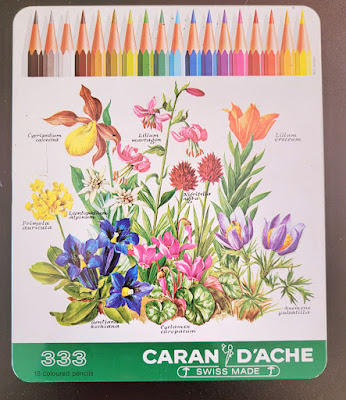 |
| Vintage Caran d'Ache non-soluble colored pencils |
 |
| The hexagonal-barrel "tulip" pencils came in this tin. |
My deduction is that the “tulip” set is more recent than the round barrel set due to the spelling difference in Suisse/Swisse, yet both tins have the “drippy paint” logo and are clearly of the same design – how much newer could it be? The tins seem to indicate they are from the same era. Another Caran d’Ache mystery.
Edited 2/18/25: A reader got in touch to say that she still has her set of 333 "tulips" that she used in high school in South Africa in 1975!
 |
| The previous owner of the "tulip" set made a swatch sheet and taped it to the lid. I love seeing evidence like this of the previous owner. |
 |
| The tin that the round-barrel (sans tulip) pencils came in -- similar design as the hexagonal set's tin. |
The more exciting news is related to my oldest set of Caran d’Ache Prismalo. An eagle-eyed blog reader contacted me when he spotted a tin of Prismalo pencils that looked like mine belonging to the sculptor Alberto Giacometti (1901 – 1966). The Fondation Giacometti has reconstructed the artist’s Paris studio with various artifacts found there upon his death. Giacometti began using the one-room studio from about the late 1920s. The reader tells me that in the latter part of Giacometti’s career, “he made his first color pencil drawings (many of which became lithographs) on the theme of ‘Man and Tree,’ so actually that tin of pencils would correspond to that.”
 |
| It's blurry here, but the tin design is clear enough to see. |
Related specifically to the Prismalo set, he says, “He wouldn’t have used them as aquarelles, but as pencils only, most famously in a series of drawings called ‘Man and Tree’ (also titled ‘L’Arbre’). I read a conversation with him where he said he had long searched for pencils that had ‘soft’ color (‘soave’ as he put it) which also corresponds to your description.”
When I Googled Giacometti’s “L’Arbre” series, I found at least one that was made with colored pencil. I found others in the series that were made with wax pastel crayons or graphite. The description on this one, made in 1952, says, “Several of these preparatory drawings to the lithograph ‘L’Arbre’, were, like this one, made with coloured pencils whose use, in Giacometti’s graphic oeuvre, is very rare.”
So although Giacometti didn’t use colored pencils often, he used this set of Prismalos sometime between the late ‘20s and early ‘50s. Based on a number of factors, I had dated my set to the 1930s, so it sounds like I was in the right ballpark.
Thank you, George, for spotting this amazing find!
For a summary of Caran d’Ache (mostly watercolor) colored pencil history as I’ve pieced it together, see this post.
 |
| My oldest set of Prismalos |
You’re welcome re the Giacometti info! Great further research you did too :-) George
ReplyDeleteI have that same 333 (x18, hexagonal) tin, which was acquired after much begging (from WHSmith in Derby, UK, in around 1977). Still much treasured! :)
ReplyDeleteA treasure, indeed! :-)
DeleteOh my I had a set from my parents around 1977, love them & the tin! Swadlincote
Delete